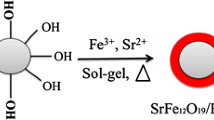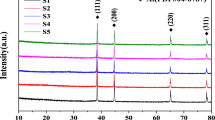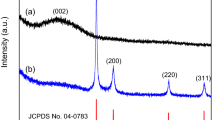Abstract
The dual-band stealth fabric was prepared by the specific procedure, as stated below: firstly, doping the polyaniline-plated hollow glass microspheres (PANI/HGMs) with the ZnO nanoparticles; subsequently, coating the aforesaid obtained substance on the Ag-deposited cellulose fabric. PANI/HGMs were produced via the in-situ polymerization of the polyaniline (PANI). And besides, the Ag-deposited cellulose fabric was prepared by the magnetron sputtering system. The scanning electron microscopy (SEM) was used to characterize the surface morphology of the coated fabric. Intended for the evaluation of the stealth effect, the infrared thermal imaging instrument and electromagnetic stealth tester were employed. The micro-structure during the reaction of coated fabric was verified through Fourier transform infrared (FTIR) and x-ray diffraction (XRD). Not only the temperature difference between upper and lower surfaces but also the results of thermal gravimetric analysis (TGA) further express the thermal stability. The coated fabric shows favorable infrared (IR) stealth effect and excellent electromagnetic interference (EMI) stealth effect, under the synergy of PANI, Ag mirror structure and ZnO nanoparticles. In addition, the EMI effect of − 50 dB can be realized at the band of 0–3 GHZ, that’s because the PANI absorbs the microwaves and the silver reflects a large number of microwaves.








Similar content being viewed by others
References
Cui Y, Gong H, Wang Y, Li D, Bai H (2018) A thermally insulating textile inspired by polar bear hair. Adv Mater. 30(141706807):1–1706807. https://doi.org/10.1002/adma.201870098
Bychanok D, Li S, Sanchez A et al (2016) Hollow carbon spheres in microwaves: bio inspired absorbing coating. Appl Phys Lett 1(108):013701. https://doi.org/10.1063/1.4938537
Zhang Z, Xu M, Ruan X, Yan J, Yun J (2017) Enhanced radar and infrared compatible stealth properties in hierarchical SnO2@ZnO nano structures. Ceram Int 3:3443–344. https://doi.org/10.1016/j.ceramint.2016.11.034
Sun G, Dong B, Cao M et al (2013) Hierarchical dendrite-like magnetic materials of Fe3O4, γ-Fe2O3, and Fe with high performance of microwave absorption. Chem Mater 23:1587–1593. https://doi.org/10.1021/cm103441u
Chen B, Zhang C (2006) Application of infrared stealth technology in military. Opt Tech 32:577–580
Huang XG, Zhang MJ, Qin YS, Chen YY (2019) Bead-like Co-doped ZnO with improved microwave absorption properties. Ceram Int. 6:45. https://doi.org/10.1016/j.ceramint.2019.01.084
Wang Yu, Wang W, Qi QB et al (2020) Layer-by-layer assembly of PDMS-coated nickel ferrite/multiwalled carbon nanotubes/cotton fabrics for robust and durable electromagnetic interference shielding. Cellulose 27:2829–2845. https://doi.org/10.1007/s10570-019-02949-1
Kong LB, Li ZW, Liu L et al (2013) Recent progress in some composite materials and structures for specific electromagnetic applications. Int Mater Rev 58:203–259. https://doi.org/10.1179/1743280412Y.0000000011
Maeda T, Sugimoto S, Kagotani T et al (2004) Effect of the soft/hard exchange interaction on natural resonance frequency and electromagnetic wave absorption of the rare earth–iron–boron compounds. J Magn Magn Mater 2:195–205. https://doi.org/10.1016/j.jmmm.2004.04.105
Akamine S (2020) Development of thermal insulating material with low emissivity and high-temperature stability. Int J Appl Ceram Tech 17:2. https://doi.org/10.1111/ijac.13369
Andersson SK, Staaf O, Olsson PO et al (1998) Infrared properties of β-sialon as a function of composition. Opt Mater 10:85–93. https://doi.org/10.1016/S0925-3467(97)00146-8
Bityukov VK, Khudak YI, Gusein NG (2018) Analytical derivation of the stefan-boltzmann law for integral radiance from planck’s law for spectral radiance. B LEBEDEV PHYS INST. 45:46–50. https://doi.org/10.3103/S1068335618020033
Gu WH, Tan JW, Chen JB (2020) Multifunctional bulk hybrid foam for infrared stealth, thermal insulation, and microwave absorption. ACS Appl Mater Inter 12:25. https://doi.org/10.1021/acsami.0c09202
Wang K, Ma Q, Zhang Y et al (2020) Ag nps-assisted synthesis of stable cu nps on pet fabrics for antibacterial and electromagnetic shielding performance. Polymers 12:783
Asghar A, Ahmad MR, Yahya MF et al (2018) An alternative approach to design conductive hybrid cover yarns for efficient electromagnetic shielding fabrics. J IND TEXT 48:38–57. https://doi.org/10.1177/1528083717721922
Fu H, Yang Z, Zhang Y et al (2020) SWCNT-modulated folding-resistant sandwich-structured graphene film for high-performance electromagnetic interference shielding. Carbon 162:490–496. https://doi.org/10.1016/j.carbon.2020.02.081
Zahidul Islam MD, Dong YB, Khoso NA et al (2019) Continuous dyeing of graphene on cotton fabric: Binder-free approach for electromagnetic shielding. Applied Surface ence. https://doi.org/10.1016/j.apsusc.2019.143636
Dakshayini BS et al (2019) Role of conducting polymer and metal oxide-based hybrids for applications in ampereometric sensors and biosensors. Microchemical Journal 147(7–24):2019. https://doi.org/10.1016/j.microc.2019.02.061
Manigandan S et al (2019) Effects of nanoadditives on emission characteristics of engine fuelled with biodiesel. Energy Sources Part A Recovery Utilization & Environmental Effects. https://doi.org/10.1080/15567036.2019.1587048
Long J, Jiang CW, Zhu JD et al (2020) Controlled TiO2 coating on hollow glass microspheres and their reflective thermal insulation properties. Particuology 49:33–39. https://doi.org/10.1016/j.partic.2019.03.002
Xu R, Wang W, Yu D (2019) Preparation of silver-plated hollow glass microspheres and its application in infrared stealth coating fabrics. Progress in Organic Coatings 131:1–10. https://doi.org/10.1016/j.porgcoat.2019.02.009
Reddy KR et al (2019) Organic Conjugated Polymer-Based Functional Nanohybrids. Polymer Composites with Functionalized Nanoparticles. https://doi.org/10.1016/B978-0-12-814064-2.00011-1
Prabhu R et al (2021) Novel polyaniline-fly ash nanohybrids synthesized via inverted emulsion polymerization: Physico-chemical, thermal and dielectric properties. Materials Science for Energy Technologies 4:107–112. https://doi.org/10.1016/j.mset.2021.02.001
Prabhu R et al (2021) Novel conjugated polymer/[Cu2Cl4(m-aminophenylbenzimidazole)3] hybrid composites: synthesis, characterization and electrochemical properties. Materials Science for Energy Technologies. 4:92–99. https://doi.org/10.1016/j.mset.2021.01.001
Tang XH, Li J, Tan YJ et al (2020) Achieve high performance microwave shielding in poly(ε-caprolactone)/multi-wall carbon nanotube composites via balancing absorption in conductive domains and multiple scattering at interfaces. Appl Sur Sci 1:508. https://doi.org/10.1016/j.apsusc.2019.145178
Boukhris I, Al-Buriahi MS, Akyildirim H et al (2020) Chalcogenide glass-ceramics for radiation shielding applications. Ceram Int. https://doi.org/10.1016/j.ceramint.2020.04.281
Fan XM, Yuan RZ, Li X et al (2020) RGO-supported core-shell SiO2 @SiO2 /carbon microsphere with adjustable microwave absorption properties. Ceram Int 46:14985–14993. https://doi.org/10.1016/j.ceramint.2020.03.028
Dong X, Wang M, Tao X et al (2020) Properties of heat resistant hollow glass microsphere/phosphate buoyancy materials with different coatings. Ceram Int 46:415–420. https://doi.org/10.1016/j.ceramint.2019.08.277
Gao G, Hu Y, Jia H et al (2019) Acoustic and dielectric properties of epoxy resin/hollow glass microsphere composite acoustic materials. J Phys chem solids. https://doi.org/10.1016/j.jpcs.2019.109105
Mohammed I, Ariful R, Soumen P (2020) Effect of low concentration hollow glass microspheres on mechanical and thermomechanical properties of epoxy composites. Polym Composite 40:3493–3499. https://doi.org/10.1002/pc.25211
Zhang YL, Zang CG, Jiao QJ et al (2020) Heat-insulating materials with high-temperature resistance through binding hollow glass microspheres with vinyl-functionalized polyborosiloxane. J Mater Sci. https://doi.org/10.1007/s10853-020-05046-y
Zhang W, Zhang X, Wu Z et al (2019) Mechanical, electromagnetic shielding and gas sensing properties of flexible cotton fiber/polyaniline composites. Compos Sci Technol. https://doi.org/10.1016/j.compscitech.2019.107966
Gupta S, Chang C, Lai CH, Tai NH (2019) Hybrid composite mats composed of amorphous carbon, zinc oxide nanorods and nickel zinc ferrite for tunable electromagnetic interference shielding. Compos part b-eng 164:447–457. https://doi.org/10.1016/j.compositesb.2019.01.060
Ali O, Sahar S (2018) Electromagnetic interference attenuation and shielding effect of quaternary Epoxy-PPy/Fe3O4-ZnO nanocomposite as a broad band microwave-absorber. J Magn Magn Mater 458:335–345. https://doi.org/10.1016/j.jmmm.2018.03.050
Li Q, Zhang Z, Qi LP et al (2019) Toward the application of high frequency electromagnetic wave absorption by carbon nanostructures. Adv Sci 6:1801057. https://doi.org/10.1002/advs.201801057
Qi YJ, Qi L, Liu LP et al (2019) Facile synthesis of lightweight carbonized hydrochars decorated with dispersed ZnO nanocrystals and enhanced microwave absorption properties. Carbon 150:259–267. https://doi.org/10.1016/j.carbon.2019.05.026
Seung HL, Seunggun Y, Faisal S et al (2019) Low percolation 3D Cu and Ag shell network composites for EMI shielding and thermal conduction. Compos sci technol. https://doi.org/10.1016/j.compscitech.2019.107778
Ghosh S, Ganguly S, Das P et al (2019) (2019) Fabrication of reduced graphene oxide/silver nanoparticles decorated conductive cotton fabric for high performing electromagnetic interference shielding and antibacterial application. Fiber Polym 20:1161–1171. https://doi.org/10.1007/s12221-019-1001-7
Jia LC, Xu L, Ren F et al (2019) Stretchable and durable conductive fabric for ultrahigh performance electromagnetic interference shielding. Carbon 144:101–108. https://doi.org/10.1016/j.carbon.2018.12.034
Tan YJ, Li J, Gao Yu et al (2018) A facile approach to fabricating silver-coated cotton fiber non-woven fabrics for ultrahigh electromagnetic interference shielding. Appl surf sci 458:236–244. https://doi.org/10.1016/j.apsusc.2018.07.107
Zhang N, Huang Y, Wang MY et al (2018) Design and microwave absorption properties of thistle-like CoNi enveloped in dielectric Ag decorated graphene composites. J Colloid interf sci 18:31087. https://doi.org/10.1016/j.jcis.2018.09.016
Zhang Y, Pan T, Yang ZJ (2020) Flexible polyethylene terephthalate/polyaniline composite paper with bending durability and effective electromagnetic shielding performance. Chem Eng J. https://doi.org/10.1016/j.cej.2020.124433
Gill N, Gupta V, Tomar M et al (2020) Improved electromagnetic shielding behaviour of graphene encapsulated polypyrrole-graphene nanocomposite in X-band. Compos Sci Technol. https://doi.org/10.1016/j.compscitech.2020.108113
Saboor A, Khalid SM, Jan R et al (2019) PS/PANI/MoS2 hybrid polymer composites with high dielectric behavior and electrical conductivity for EMI shielding effectiveness. Materials 12:2690. https://doi.org/10.3390/ma12172690
Syed K (2019) Polyaniline-Graphene nanoplatelet composite films with improved conductivity for high performance X-band microwave shielding applications. Results Phys 12:1073–1081. https://doi.org/10.1016/j.rinp.2018.12.087
Liu F, Li YC, Hao S et al (2020) Well-aligned MXene/chitosan films with humidity response for high-performance electromagnetic interference shielding. Carbohyd Polym. https://doi.org/10.1016/j.carbpol.2020.116467
Sjogren B, Stafstrom S (1988) Electronic excitations in polyaniline - an indo s-cl study. J. Chem. Phys. 88:3840–3847. https://doi.org/10.1063/1.453885
Wang Y, Wang W, Yu D (2017) Three-phase heterostructures f-NiFe2O4/PANI/PI EMI shielding fabric with high microwave absorption performance. Appl. Surf. Sci. 425:518–525. https://doi.org/10.1016/j.apsusc.2017.07.062
Mahesh B et al (2019) Miscibility studies of plastic-mimetic polypeptide with hydroxypropylmethylcellulose blends and generation of non-woven fabrics. Carbohydrate Polymers. https://doi.org/10.1016/j.carbpol.2019.02.042
Kang JF et al (2020) Structure, dielectric property and viscosity of alkali-free boroaluminosilicate glasses with the substitution of Al2O3 for SiO2. Journal of Non-Crystalline Solids. https://doi.org/10.1016/j.jnoncrysol.2020.120022
Bora MM, Deka C et al (2018) Alkyds from red silkcotton (Bombax ceiba) seed oil and investigation on their microbial degradation. Prog. Org. Coat. 124:71–79. https://doi.org/10.1016/j.porgcoat.2018.08.008
Yakushin V et al (2013) Synthesis and ChaCation of Novel Polyurethanes Based on Tall Oil. Materials Science-medziagotyra 19(4): 390–396. https://doi.org/10.5755/j01.ms.19.4.2666
Nanjundaswamy GS, Mahesh B, Channe GD (2018) Elastin-based polymer; synthesis, characterization and examination of its miCc characteristics with polyvinylalcohol and electrospinning of the miscible blends. Polymer International. Doi: https://doi.org/10.1002/pi.5669
Ghahfarokhi S, Ahmadi M, Kazeminezhad I (2021) Effect of the pani content on curie temperature and microwave absorption properties of Srfe 11 MnO19 /Cofe1.9Bi0.1O4 nanocomposite. Appl Phys A-Mater 127: 401. https://doi.org/10.1007/s00339-021-04556-z
Simdar M, Mousavi SS, Sajad B et al (2021) Distinctive ZnO films structures and morphologies for different modes of the heating substrate. Materials Letters. https://doi.org/10.1016/j.matlet.2021.129914
Li lL, Dan Y, et al (2012) Electroless silver plating on the PET fabrics modifified with 3-mercaptopropyltriethoxysilane. J Appl Polym Sci 124:1912–1918. https://doi.org/10.1016/j.apsusc.2015.06.126
Acknowledgements
This work was supported by the National Natural Science Foundation of China (Grant No. 11702169), Talents Action Program of Shanghai University of Engineering Science (Grant No. 2017RC522017), Shanghai Local Capacity-Building Project (Grant No. 19030501200) and Research and Innovation Project of Shanghai University of Engineering Science (Grant No. 20KY0901).
Author information
Authors and Affiliations
Corresponding authors
Additional information
Publisher's Note
Springer Nature remains neutral with regard to jurisdictional claims in published maps and institutional affiliations.
Rights and permissions
About this article
Cite this article
Zhou, X., Xin, B., Chen, Z. et al. Preparation of PANI-coated hollow glass microsphere and its application in dual-band stealth coated fabric. Polym. Bull. 79, 7555–7570 (2022). https://doi.org/10.1007/s00289-021-03854-z
Received:
Revised:
Accepted:
Published:
Issue Date:
DOI: https://doi.org/10.1007/s00289-021-03854-z




